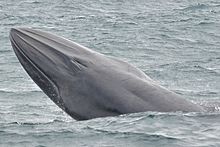
The blue whale is a marine mammal and a baleen whale. Reaching a maximum confirmed length of 29.9 meters (98 ft) and weighing up to 199 tonnes, it is the largest animal known ever to have existed. The blue whale's long and slender body can be of various shades of greyish-blue dorsally and somewhat lighter underneath. Four subspecies are recognized: B. m. musculus in the North Atlantic and North Pacific, B. m. intermedia in the Southern Ocean, B. m. brevicauda in the Indian Ocean and South Pacific Ocean, and B. m. indica in the Northern Indian Ocean. There is also a population in the waters off Chile that may constitute a fifth subspecies.

The gray whale, also known as the grey whale, gray back whale, Pacific gray whale, Korean gray whale, or California gray whale, is a baleen whale that migrates between feeding and breeding grounds yearly. It reaches a length of 14.9 meters (49 ft), a weight of up to 41 tonnes (90,000 lb) and lives between 55 and 70 years, although one female was estimated to be 75–80 years of age. The common name of the whale comes from the gray patches and white mottling on its dark skin. Gray whales were once called devil fish because of their fighting behavior when hunted. The gray whale is the sole living species in the genus Eschrichtius. It is the sole living genus in the family Eschrichtiidae, however some recent studies classify it as a member of the family Balaenopteridae. This mammal is descended from filter-feeding whales that appeared during the Neogene.

Whales are a widely distributed and diverse group of fully aquatic placental marine mammals. As an informal and colloquial grouping, they correspond to large members of the infraorder Cetacea, i.e. all cetaceans apart from dolphins and porpoises. Dolphins and porpoises may be considered whales from a formal, cladistic perspective. Whales, dolphins and porpoises belong to the order Cetartiodactyla, which consists of even-toed ungulates. Their closest non-cetacean living relatives are the hippopotamuses, from which they and other cetaceans diverged about 54 million years ago. The two parvorders of whales, baleen whales (Mysticeti) and toothed whales (Odontoceti), are thought to have had their last common ancestor around 34 million years ago. Mysticetes include four extant (living) families: Balaenopteridae, Balaenidae, Cetotheriidae, and Eschrichtiidae. Odontocetes include the Monodontidae, Physeteridae, Kogiidae, and Ziphiidae, as well as the six families of dolphins and porpoises which are not considered whales in the informal sense.

Rorquals are the largest group of baleen whales, comprising the family Balaenopteridae, which contains ten extant species in three genera. They include the largest known animal that has ever lived, the blue whale, which can reach 180 tonnes, and the fin whale, which reaches 120 tonnes ; even the smallest of the group, the northern minke whale, reaches 9 tonnes.

The fin whale, also known as the finback whale or common rorqual, is a species of baleen whale and the second-longest cetacean after the blue whale. The biggest individual reportedly measured 26 m (85 ft) in length, with a maximum recorded weight of 77,000–81,000 kg (170,000–179,000 lb). The fin whale's body is long, slender and brownish-gray in color, with a paler underside to appear less conspicuous from below (countershading).

Baleen whales, also known as whalebone whales, are marine mammals of the parvorder Mysticeti in the infraorder Cetacea which use keratinaceous baleen plates in their mouths to sieve planktonic creatures from the water. Mysticeti comprises the families Balaenidae, Balaenopteridae (rorquals), Eschrichtiidae and Cetotheriidae. There are currently 16 species of baleen whales. While cetaceans were historically thought to have descended from mesonychians, molecular evidence instead supports them as a clade of even-toed ungulates (Artiodactyla). Baleen whales split from toothed whales (Odontoceti) around 34 million years ago.

The minke whale, or lesser rorqual, is a species complex of baleen whale. The two species of minke whale are the common minke whale and the Antarctic minke whale. The minke whale was first described by the Danish naturalist Otto Fabricius in 1780, who assumed it must be an already known species and assigned his specimen to Balaena rostrata, a name given to the northern bottlenose whale by Otto Friedrich Müller in 1776. In 1804, Bernard Germain de Lacépède described a juvenile specimen of Balaenoptera acuto-rostrata. The name is a partial translation of Norwegian minkehval, possibly after a Norwegian whaler named Meincke, who mistook a northern minke whale for a blue whale.

The common minke whale or northern minke whale is a species of minke whale within the suborder of baleen whales.
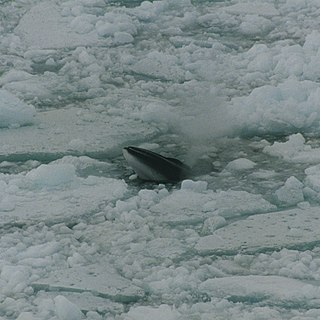
The Antarctic minke whale or southern minke whale is a species of minke whale within the suborder of baleen whales. It is the second smallest rorqual after the common minke whale and the third smallest baleen whale. Although first scientifically described in the mid-19th century, it was not recognized as a distinct species until the 1990s. Once ignored by the whaling industry due to its small size and low oil yield, the Antarctic minke was able to avoid the fate of other baleen whales and maintained a large population into the 21st century, numbering in the hundreds of thousands. Surviving to become the most abundant baleen whale in the world, it is now one of the mainstays of the industry alongside its cosmopolitan counterpart the common minke. It is primarily restricted to the Southern Hemisphere and feeds mainly on euphausiids.
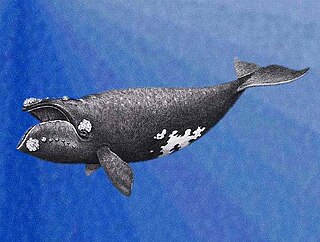
The North Pacific right whale is a very large, thickset baleen whale species that is extremely rare and endangered.

The pygmy right whale is a species of baleen whale. It may be a member of the cetotheres, a family of baleen whales which until 2012 were thought to be extinct; C. marginata has otherwise been considered the sole member of the family Neobalaenidae and is the only member of the genus Caperea. First described by John Edward Gray in 1846, it is the smallest of the baleen whales, ranging between 6 and 6.5 metres in length and 3,000 and 3,500 kilograms in mass. Despite its name, the pygmy right whale may have more in common with the gray whale and rorquals than the bowhead and right whales.
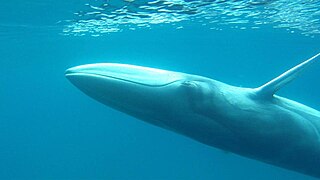
Omura's whale or the dwarf fin whale is a species of rorqual about which very little is known. Before its formal description, it was referred to as a small, dwarf or pygmy form of Bryde's whale by various sources. The common name and specific epithet commemorate Japanese cetologist Hideo Omura.

Balaenoptera is a genus of rorquals containing eight extant species. Balaenoptera comprises all but two of the extant species in its family ; the genus is currently polyphyletic, with the two aforementioned species being phylogenetically nested within it.
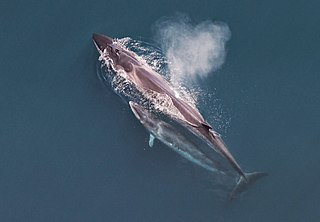
The sei whale is a baleen whale. It is one of ten rorqual species, and the third-largest member after the blue and fin whales. They can grow up to 19.5 m (64 ft) in length and weigh as much as 28 t. Two subspecies are recognized: B. b. borealis and B. b. schlegelii. The whale's ventral surface has sporadic markings ranging from light grey to white, and its body is usually dark steel grey in colour. It is among the fastest of all cetaceans, and can reach speeds of up to 50 km/h (31 mph) over short distances.

Rice's whale, also known as the Gulf of Mexico whale, is a species of baleen whale endemic to the northern Gulf of Mexico. Initially identified as a subpopulation of the Bryde's whale, genetic and skeletal studies found it to be a distinct species by 2021. In outward appearance, it is virtually identical to the Bryde's whale. Its body is streamlined and sleek, with a uniformly dark charcoal gray dorsal and pale to pinkish underside. A diagnostic feature often used by field scientists to distinguish Rice's whales from whales other than the Bryde's whale is the three prominent ridges that line the top of its head. The species can be distinguished from the Bryde's whale by the shape of the nasal bones, which have wider gaps due to a unique wrapping by the frontal bones, its unique vocal repertoire, and genetic differences.
Cetaceans form an infra-order of marine mammals. In 2020, approximately 86 species of cetaceans had been identified worldwide. Among these species, at least 35 have been sighted in the wider Caribbean region with very widespread distribution and density variations between areas. Caribbean waters are a preferred breeding site for several species of mysticeti, who live further north the rest of the year. The tucuxi and the boto live at the southern periphery of the Caribbean region in the freshwaters of the Amazon river and surrounding drainage basins.














